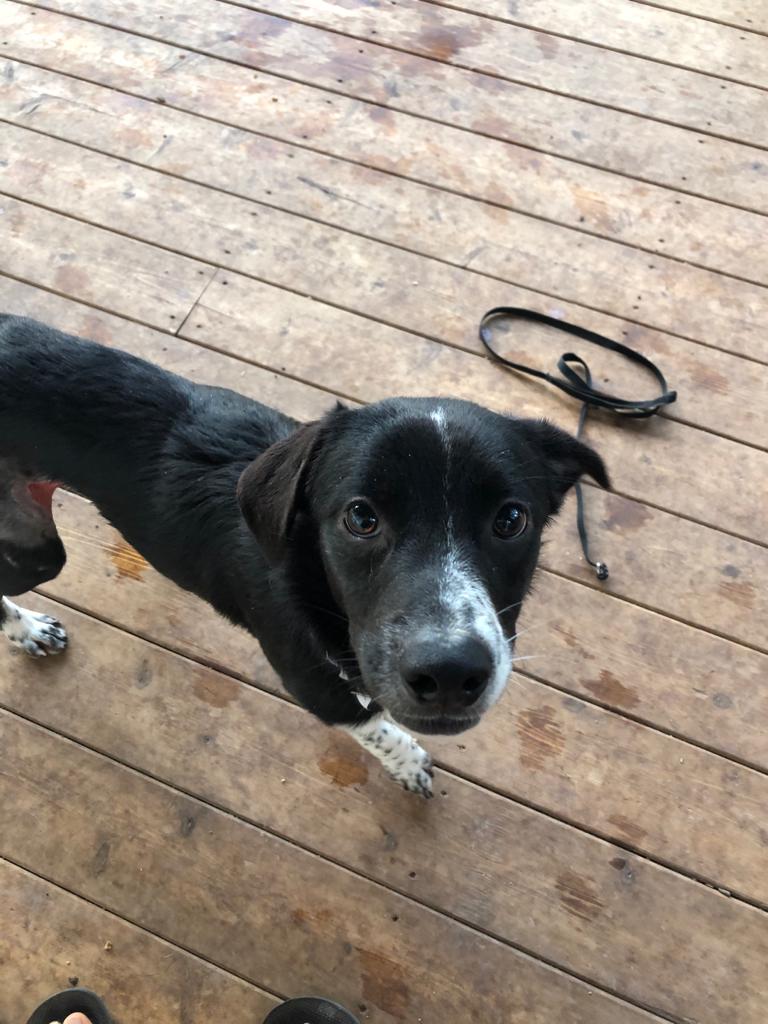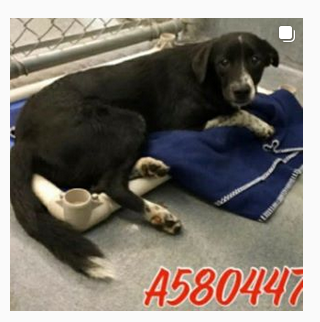I wake early and feel the sunshine pulling us into the day.
The Steller’s jays are dancing in the pines, celebrating the peanut breakfast we provided on our flagstone steps. I’m grateful for a solid evening of sleep. Since taking on rescue dog advocacy a few months ago, a solid eight is never a guarantee.
This morning, a calm looms over our valley. It’s a Tuesday, and lying ahead is a day of rescue dogs in need. As I scroll through the most urgent ones on my Instagram feed, I think of a dog I recently became involved in helping.
His name is Flynn. I recall his inmate number, like a prisoner: A58044. Except unlike a prisoner, his innocence is unquestioned.
He was in the San Antonio Shelter, unjustifiably incarcerated after being loved by no one and cared for by few. He’d been brought in by a Good Samaritan, who found him injured and limping on a San Antonio street. His excruciating pain was so readily apparent as to warrant a shelter veterinary exam. His tail was wrapped, medicine administered, notes written.
The cause of his injuries was unknown, along with any possible requirements and cost for treatment and care.
It’s the kind of occasion giving us all pause, when the chances that a dog entering a shelter will make it back out on all four feet are 50/50 on a good day. For a dog with medical needs in a beleaguered and overwhelmed shelter, those odds are considerably worse.
Even more dramatic than the burns on his stomach revealed during the examination was the Code Red Status the shelter staff assigned to him. In the rescue dog world, it means: If someone doesn’t get me, they’re gonna stick a lethal needle in my paw and I’ll be gone forever. My injuries are too difficult and costly for anyone here to take on.
Networkers, coordinators, advocates, and the rescues themselves all jump on communication for a Code Red Status like white on rice.
SOS, urgent! Emergency! Needs out or will die!
Captions accompany the dog’s plight, shared across accounts. Nearby foster-based rescues are tagged. Can you help? Calls are made to the shelter for updates. Communication becomes critical and misinformation on a platform like Instagram can fly about like a magic carpet in a Disney cartoon.
All the while, this sweet two-year-old Border collie mix sat in his cage, unaware of the efforts being made on his behalf. I have a particular affinity for Border collie mutts, having had my own—Cody and Rainier—in my home. They lived for 15 and 17 long years, tireless performing their job of herding our longhorn heifer and Belgian draft horse back and forth across our valley. I know them to be good with just about everyone; I was certain that Flynn was just such a dog.
My heart was aching for Flynn’s situation—unemployed (Borders love to have jobs, or else they become self-employed), homeless, with injuries threatening his very life. Whatever misfortune or abuse befell him, it was through no fault of his own.
Even worse, a timeframe loomed around Flynn’s stay in the San Antonio Shelter like the Grim Reaper looming around the kennel door.
I went the extra steps of reaching out to the shelter directly, researching nearby rescues in the geographic vicinity with pull privileges (the legal right to pull a dog from an established nonprofit rescue) with the shelter. Making matters more stressful and his situation more dire, the shelter was closed for adoptions to the general public, just as with almost all shelters during this interminable pandemic. Potential adopters can call for a meet and greet, but nobody had yet called for Flynn.
It becomes a miraculous event, then, an act of serendipity or turn of fate, when a dog is rescued out of a shelter before the high-heeled, official-looking woman or block-heeled, stoic-looking man with a clipboard walks by the kennel, glances in, and asks, How long has this dog been here?
Those of us in the rescue dog movement are all too aware that statistically speaking, no-kill status for a shelter is an ideal worth striving for when hearts and minds are aligned, and a challenge to achieve in socioeconomically-deprived areas. In municipal shelters, funds are often limited, making the relationship between rescues and shelters a critical resource to help more animals find safe exit.
Even more miraculous—perhaps serendipitous—is when a dog like Flynn comes up in my Instagram feed. There are literally hundreds daily needing rescue around the nation.
In the process, there is always one on any particular Tuesday, that pulls at your heart to go above and beyond. I knew I could at least try to help Flynn, if I could just beat the shelter clock.
I reached out to Central Texas Ruffugees, a nonprofit in Austin, Texas. Can you help pull this dog out of harm’s way? I asked.
Sure, we have pull privileges, but no fosters. Where can he go after we pull him?
Blood drained from my face; I was still learning the process of dog rescue, the system by which everyone operates. It’s a loose affiliation of relationships among rescues, and I was new.
Nonetheless, I promised to reach out to a Colorado rescue to find placement for Flynn.
It went on like this, back-and-forth, for the day. I reached out to a fellow networker: Share, share, please share! Time is limited—needs medical attention! I asked Sheryl, who created Pet Pardon, to post him on her app so that people could begin pledging donations for his care. I sent DMs back-and-forth with Central Texas Ruffugees, confirming their willingness to help if we could just find a place for Flynn to go.
And all the while, Flynn sat in the shelter, unable to play with other dogs for the burns on his belly.
It begged the question: What was really wrong with him? The shelter hadn’t sufficient resources for thorough examination or treatment. He would need a medical sponsor, someone with money to help pay for his care. Other questions arose, to which I had no answer:
Does Flynn get along with other dogs? I couldn’t say—his notes were silent.
Has he ever had a bite incident, a history of aggression? I didn’t know…
It was obvious I was groping in the dark, and the good people at the shelter, despite their best intentions, were flying equally blind. Flynn was a stray, and we had no knowledge of his past life.
I reached back out to Central Texas Ruffugees. Do you have a foster yet?
No, not yet, I sighed.
We send all our dogs up north, my friend said. Texas is a high-kill state.
Yep, I already knew that. Our own dog, Smudges, came from Breckenridge near Dallas. Our friend’s dog came from Laredo. A young rescue here in the Denver Metro Area—Up Pup and Away—pulls dogs out of Big Springs, Texas. It’s well-known here in Colorado that dogs from the southern shelters are finding their way onto our trails in the company of willing hearts.
Sadly, many more are left behind to become statistics.
I wasn’t going to let that happen to Flynn. There was something heartrending about a dog this young and vulnerable with treatable injuries screaming at me to find a resolution. I needed to save him as much as he needed saving.
I continued calling Colorado rescues, until I found a rescue that I’d learned had a solid reputation for being professional and most importantly, communicative in a timely manner.
If I can get Central Texas Ruffugees to pull him, I asked Floss from Denkai Animal Sanctuary in Cortez, Can you take him into foster?
I’m sure we could help, she said. I sat down as tears welled up. And then she asked, But how would he get here?
I had no idea. All I knew was he needed transport—another aspect of rescue dog advocacy—to bring him from San Antonio and up into Colorado into a welcoming lap of safety. What was more, the cost of transport is a ubiquitous responsibility that’s about as popular to pick up as a check at a five-star restaurant. There are volunteer pilots moving dogs about the nation, vans on highways with lucky canine refugees—but I didn’t know where to begin.
Even more grave, I didn’t know the cost for Flynn’s injuries, and I sure didn’t know that the strange Scottish woman from our rescue dog advocacy group would eventually bail on her offer to be his medical sponsor while invoking a divinely-inspired cure on Flynn’s behalf in lieu of veterinary treatment.
I also didn’t know that the founder of Central Texas Ruffugees, Marla, and her loving husband would be driving up from San Antonio, through Colorado, and into Montana within the next week, and that they were willing to bring Flynn to a foster waiting in Greeley who would take him into her home, and the next day, to a vet as well.
What I know now, looking back on that rescue, was that serendipity, divine force, and dozens of hearts came together to work on behalf of one gravely injured young Border collie mutt named Flynn.
It turned out that Flynn had a severe infection in his spine and thus lost his tail (and his gonads—please spay and neuter your animals). But in the process, he gained an opportunity to become a forever-grateful, loving, and healthy dog in his foster home. I lost some space on my credit card, but it was well worth it to step in and become his sponsor. He not only gets to play with his foster’s children happily on their farm in Northern Colorado, but gets to sit and stare at their chickens as they cluck-cluck-cluck about, happily pecking on the ground.
For Flynn, it’s my prayer that one day in the not-too-distant future, he will become yet another of those dogs with a happy ending, who found his forever home in the Rocky Mountains of Colorado, or a farm on the plains, thanks to the Herculean efforts of aligned hearts and committed bodies working to save yet another beautiful canine life.
Namaste, and thank you for reading.












Read 0 comments and reply